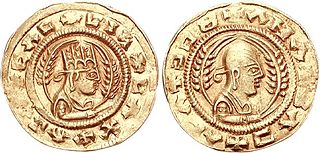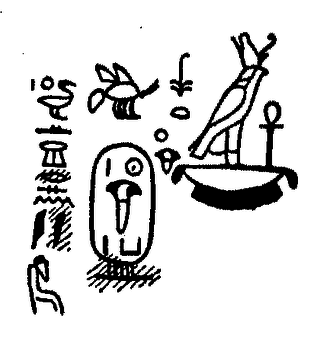
Nubians are a Nilo-Saharan speaking ethnic group indigenous to the region which is now northern Sudan and southern Egypt. They originate from the early inhabitants of the central Nile valley, believed to be one of the earliest cradles of civilization. In the southern valley of Egypt, Nubians differ culturally and ethnically from Egyptians, although they intermarried with members of other ethnic groups, especially Arabs. They speak Nubian languages as a mother tongue, part of the Northern Eastern Sudanic languages, and Arabic as a second language.

The Middle Kingdom of Egypt is the period in the history of ancient Egypt following a period of political division known as the First Intermediate Period. The Middle Kingdom lasted from approximately 2040 to 1782 BC, stretching from the reunification of Egypt under the reign of Mentuhotep II in the Eleventh Dynasty to the end of the Twelfth Dynasty. The kings of the Eleventh Dynasty ruled from Thebes and the kings of the Twelfth Dynasty ruled from el-Lisht.

Makuria was a medieval Nubian kingdom in what is today northern Sudan and southern Egypt. Its capital was Dongola in the fertile Dongola Reach, and the kingdom is sometimes known by the name of its capital.

Old Nubian is an extinct Nubian language, attested in writing from the 8th to the 15th century AD. It is ancestral to modern-day Nobiin and closely related to Dongolawi and Kenzi. It was used throughout the kingdom of Makuria, including the eparchy of Nobatia. The language is preserved in more than a hundred pages of documents and inscriptions, both of a religious nature, and related to the state and private life, written using adaptation of the Coptic alphabet.

The Meroitic script consists of two alphasyllabic scripts developed to write the Meroitic language at the beginning of the Meroitic Period of the Kingdom of Kush. The two scripts are Meroitic Cursive, derived from Demotic Egyptian, and Meroitic Hieroglyphs, derived from Egyptian hieroglyphs. Meroitic Cursive is the most widely attested script, constituting ~90% of all inscriptions, and antedates, by a century or more, the earliest surviving Meroitic hieroglyphic inscription. Greek historian Diodorus Siculus described the two scripts in his Bibliotheca historica, Book III (Africa), Chapter 4. The last known Meroitic inscription is the Meroitic Cursive inscription of the Blemmye king, Kharamadoye, from a column in the Temple of Kalabsha, which has recently been re-dated to AD 410/ 450 of the 5th century. Before the Meroitic Period, Egyptian hieroglyphs were used to write Kushite names and lexical items.

Alodia, also known as Alwa, was a medieval kingdom in what is now central and southern Sudan. Its capital was the city of Soba, located near modern-day Khartoum at the confluence of the Blue and White Nile rivers.

Lower Nubia is the northernmost part of Nubia, roughly contiguous with the modern Lake Nasser, which submerged the historical region in the 1960s with the construction of the Aswan High Dam. Many ancient Lower Nubian monuments, and all its modern population, were relocated as part of the International Campaign to Save the Monuments of Nubia; Qasr Ibrim is the only major archaeological site which was neither relocated nor submerged. The intensive archaeological work conducted prior to the flooding means that the history of the area is much better known than that of Upper Nubia. According to David Wengrow, the A-Group Nubian polity of the late 4th millenninum BCE is poorly understood since most of the archaeological remains are submerged underneath Lake Nasser.
The Philae temple complex is an island-based temple complex in the reservoir of the Aswan Low Dam, downstream of the Aswan Dam and Lake Nasser, Egypt.

Senusret I also anglicized as Sesostris I and Senwosret I, was the second pharaoh of the Twelfth Dynasty of Egypt. He ruled from 1971 BC to 1926 BC, and was one of the most powerful kings of this Dynasty. He was the son of Amenemhat I. Senusret I was known by his prenomen, Kheperkare, which means "the Ka of Re is created." He expanded the territory of Egypt allowing him to rule over an age of prosperity.

Dotawo was a Christian kingdom in Lower Nubia in the Middle Ages. It is attested in Old Nubian documents from the 12th to the 15th centuries. It is one of the last attested Christian states to survive in the region.

Kaleb, also known as Saint Elesbaan, was King of Aksum, which was situated in modern-day Ethiopia and Eritrea

Nobatia or Nobadia was a late antique kingdom in Lower Nubia. Together with the two other Nubian kingdoms, Makuria and Alodia, it succeeded the kingdom of Kush. After its establishment in around 400, Nobadia gradually expanded by defeating the Blemmyes in the north and incorporating the territory between the second and third Nile cataract in the south. In 543, it converted to Coptic Christianity. It would then be annexed by Makuria, under unknown circumstances, during the 7th century.
The Monumentum Adulitanum, so named by Leo Allatius, was an ancient inscription written in Greek, depicting the military campaigns of an anonymous king. The original text was inscribed on a throne in Adulis. Although the inscription has never been discovered by archaeologists, it is known about through the copying of the inscription by Cosmas Indicopleustes, a 6th-century Greek traveler-monk. The text narrates the king's military campaigns in the African continent and in the Arabian peninsula. It is thought to be between 200 and 270 AD.

The Kingdom of Aksum also known as the Kingdom of Axum, or the Aksumite Empire, was a kingdom in East Africa and South Arabia from classical antiquity to the Middle Ages. Based in what is now northern Ethiopia and Eritrea, and spanning present-day Djibouti and Sudan. Emerging from the earlier Dʿmt civilization, the kingdom was founded in 1st century. The city of Axum served as the kingdom's capital for many centuries until it relocated to Kubar in the 9th century due to declining trade connections and recurring external invasions.

Nubia is a region along the Nile river encompassing the area between the first cataract of the Nile and the confluence of the Blue and White Niles, or more strictly, Al Dabbah. It was the seat of one of the earliest civilizations of ancient Africa, the Kerma culture, which lasted from around 2500 BC until its conquest by the New Kingdom of Egypt under Pharaoh Thutmose I around 1500 BC, whose heirs ruled most of Nubia for the next 400 years. Nubia was home to several empires, most prominently the Kingdom of Kush, which conquered Egypt in the eighth century BC during the reign of Piye and ruled the country as its 25th Dynasty.

The Kingdom of Kush, also known as the Kushite Empire, or simply Kush, was an ancient kingdom in Nubia, centered along the Nile Valley in what is now northern Sudan and southern Egypt.

Meinarti was an island with a Nubian village in northern Sudan. Situated in the Nile, Meinarti was just north of the 2nd Cataract, a few kilometers upstream of the Sudanese border town of Wadi Halfa. On the island was an artificial mount 175m long and 12.5m high, consisting of stratified archaeological remains. When excavated it proved to contain 18 recognizable levels, the result of six separate and distinct phases of occupation. Each phase was followed by a period of abandonment and then a complete rebuilding. Structural remains at all phases were entirely of mud brick. Meinarti was excavated by William Yewdale Adams from 1962 to 1964, prior to perishing in the 1960s with the rising of Lake Nubia due to the Aswan Dam.

Segerseni was an ancient Egyptian or Nubian chieftain of Nubia, likely reigning concurrently with the end of the 11th and beginning of the 12th Dynasty during the early Middle Kingdom.
Qakare Ini was an ancient Egyptian or Nubian ruler who most likely reigned at the end of the 11th and beginning of the 12th Dynasty over Lower Nubia. Although he is the best attested Nubian ruler of this time period, nothing is known of his activities.

Gebel Adda was a mountain and archaeological site on the right bank of the Nubian Nile in what is now southern Egypt. The settlement on its crest was continuously inhabited from the late Meroitic period to the Ottoman period, when it was abandoned by the late 18th century. It reached its greatest prominence in the 14th and 15th centuries, when it seemed to have been the capital of late kingdom of Makuria. The site was superficially excavated by the American Research Center in Egypt just before being flooded by Lake Nasser in the 1960s, with much of the remaining excavated material, now stored in the Royal Ontario Museum in Canada, remaining unpublished. Unearthed were Meroitic inscriptions, Old Nubian documents, a large amount of leatherwork, two palatial structures and several churches, some of them with their paintings still intact. The nearby ancient Egyptian rock temple of Horemheb, also known as temple of Abu Oda, was rescued and relocated.